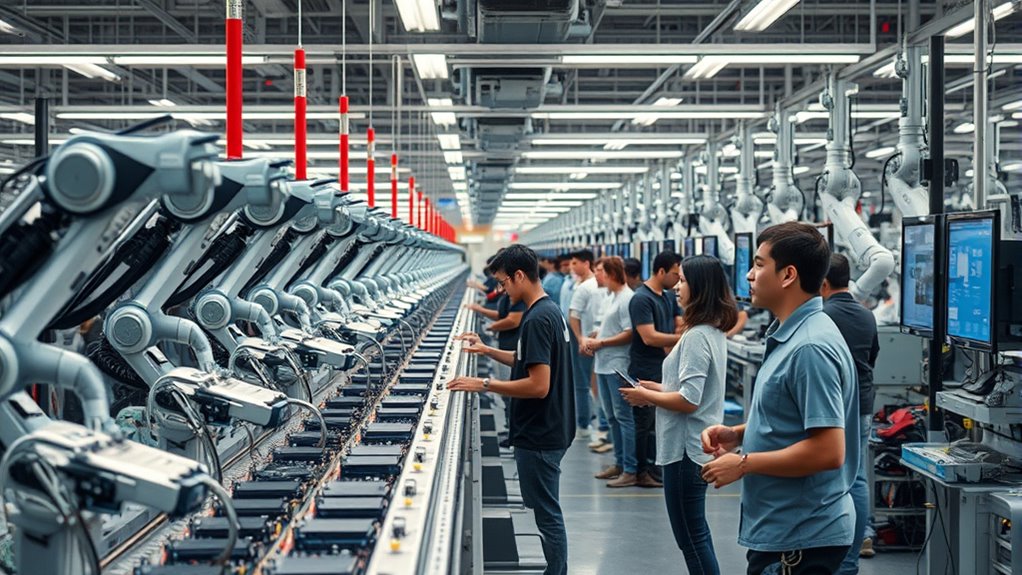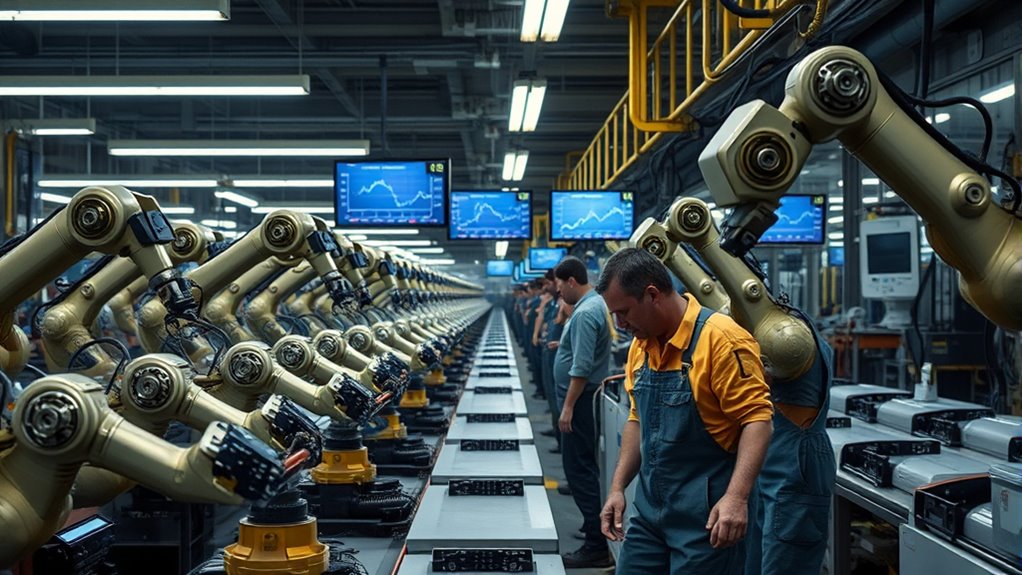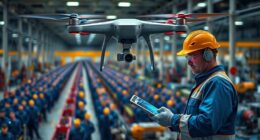Automation is transforming economies and changing job opportunities, especially for the middle class. As routine middle-skilled tasks become automated, many of these jobs shrink or disappear, leading to job polarization. High-skilled roles often benefit, but low-skilled jobs face decline, which can widen wage gaps and threaten job security. If you want to understand how policies and skills development can help protect your future amid these changes, there’s more to explore.
Key Takeaways
- Automation increasingly targets routine middle-skilled jobs, leading to job displacement and reducing middle-class employment opportunities.
- Wages for middle-income roles decline as automation weakens workers’ bargaining power and shifts employment toward high- and low-wage sectors.
- Middle-wage job numbers are shrinking due to automation’s focus on routine tasks, causing labor market polarization.
- Reskilling and upskilling initiatives are essential to prevent middle-class workers from being displaced by automation.
- Policy efforts, including education and social safety nets, are critical for maintaining middle-class stability amid technological change.
The Shift in Employment Patterns and Job Polarization

Recent trends suggest that the traditional pattern of job polarization is changing, with automation increasingly fueling a shift toward high-skilled positions. Instead of growing mainly in low- and middle-skilled jobs, employment is now moving toward high-skilled roles like those in STEM fields. The share of STEM jobs has jumped from 6.5% in 2010 to nearly 10% in 2024, showing a clear trend toward specialized, high-demand work. Automation has made routine middle-skilled jobs more vulnerable, pushing workers to upgrade their skills to stay relevant. Reskilling initiatives are becoming essential to help workers adapt to these evolving demands. While some fear this could hollow out the middle class, others see new opportunities in high-tech sectors. Globally, AI and robotics are expected to create up to 97 million new jobs by 2025, signaling a significant shift in employment patterns. Additionally, advancements in home automation technology are transforming workplace environments and skill requirements across industries.
How Automation Enhances Productivity and Affects Wages

Automation increases your workplace’s efficiency by streamlining tasks and reducing errors, helping companies produce more with less. As a result, costs go down, and consumers often benefit from lower prices. However, these productivity gains can also shift wages, often widening gaps between high- and low-skilled workers. Additionally, the adoption of sound design and other home decor solutions can reflect broader technological trends that influence lifestyle and economic patterns. Understanding the difference between ethical hacking and other cybersecurity roles can also shed light on how specialized skills are increasingly valued in the tech-driven economy. Recognizing signs of spoiled lemon juice can also be important in maintaining health and safety standards in food consumption. Moreover, as businesses adopt new payment technologies, they must also navigate regulatory compliance challenges to avoid legal pitfalls.
Boosts Economic Efficiency
By increasing productivity and streamlining operations, automation considerably boosts economic efficiency across industries. When you adopt robots and advanced systems, you see a direct link to higher output—each 1% increase in robot density can raise productivity by nearly 0.8%. In sectors like education, construction, and agriculture, gains can reach up to 5.1%. Automation in manufacturing, especially automotive and electronics, drives significant improvements. Generative AI further enhances productivity, adding value to the global economy. Over 78% of business leaders agree that automation positively impacts organizational productivity. Automated processes reduce manual errors, enable 24/7 operations, and cut costs. They also improve data analysis, supporting better decision-making and making industries more flexible and competitive. Additionally, Hybrid Tuning techniques demonstrate how tailored technological adjustments can optimize performance and efficiency. Implementing continuous improvement practices ensures that automation remains effective and adaptable to evolving market demands. Furthermore, the integration of technological advancements accelerates innovation and helps industries stay ahead of competitors. The adoption of persuasive communication strategies can further enhance the effectiveness of automation by aligning team efforts with organizational goals. Overall, automation fuels economic growth by making operations more efficient and effective.
Influences Wage Dynamics
Automation profoundly influences wage dynamics by reshaping how labor markets function and determining workers’ earnings. It boosts productivity, helping companies produce more efficiently, but can weaken workers’ bargaining power, often limiting wage growth. Automation creates new jobs requiring skills that complement machines, especially for high-skilled workers, while displacing low-skilled roles, widening wage gaps. Firms are incentivized to invest in automation to maximize profits, which can increase wage disparities. The table below highlights how automation impacts different skill levels:
| Skill Level | Wage Impact |
|---|---|
| High-skilled | Wages tend to rise when working alongside automation |
| Low-skilled | Often face wage decline or job loss |
| Mid-skilled | Experience mixed effects depending on sector |
| Automation-driven | Creates some jobs but displaces others |
| Wage inequality | Widens as high-skilled workers benefit more |
Ultimately, automation shapes wage dynamics by altering job opportunities and wage structures across sectors. Additionally, automation can influence labor market flexibility, impacting how easily workers can transition between jobs and adapt to changing skill requirements. This flexibility is crucial for maintaining a resilient workforce in a rapidly evolving economic landscape. Moreover, the increasing reliance on automation can lead to shifts in employment patterns, affecting overall job stability and income levels.
The Role of AI in Displacing Middle-Class Jobs

AI is automating routine tasks that many middle-class jobs rely on, making these roles more vulnerable to displacement. As machines handle repetitive work, fewer workers are needed, and job security diminishes. This shift challenges the traditional stability of middle-income careers, forcing workers to adapt or face unemployment. Moreover, the rise in sophisticated cyber threats underscores the importance of AI security in safeguarding sensitive information and maintaining trust in digital systems. Additionally, developing emotional support strategies for displaced workers can help them navigate the psychological impacts of job loss during this transition. With ongoing developments, ensuring AI safety measures are robust becomes crucial to prevent vulnerabilities that could be exploited. Effective credit card management practices can also aid individuals in maintaining financial stability amidst economic shifts.
AI Replacing Routine Tasks
As AI becomes increasingly capable of handling routine tasks, many middle-class jobs face significant disruption. AI is automating tasks like scheduling meetings and generating reports, which are common in many jobs. Around 25% of these routine activities are already robotized, boosting productivity and freeing workers for more complex work. You’ll see AI improving customer support by handling more inquiries per hour, increasing efficiency and quality. Generative AI tools also deliver performance gains, with an average 66% boost in task efficiency. This shift underscores the importance of ongoing due diligence in assessing how automation impacts job markets and individual career trajectories. Additionally, the proliferation of automation technologies accelerates the pace at which industries adapt and evolve, often reshaping traditional employment landscapes. The adoption of specialized tools like smart planters and self-watering pots exemplifies how automation and innovative technology are transforming various industries and daily activities. As technological advancements continue to evolve, workforce adaptation becomes increasingly crucial to prevent widespread displacement and to foster new opportunities. Moreover, understanding the role of industrial automation can help policymakers and businesses develop strategies for workforce reskilling and economic resilience.
Middle-Class Job Vulnerability
Are middle-class jobs truly safe from the rapid advances in artificial intelligence? The truth is, AI could replace or degrade up to 300 million jobs worldwide, hitting sectors like writing, software development, and data analysis. AI’s capabilities in manufacturing, data entry, and customer service are expanding fast, putting many middle-class roles at risk. Historically, technology threatened jobs, but AI now targets a broader range, including skilled positions. By 2030, around 14% of the global workforce might need to change careers due to AI. CEOs predict significant job cuts, especially in middle-class professions. While new jobs may emerge, the displacement could widen economic inequality and threaten social stability unless policies support workforce adaptation and retraining. Widespread automation could affect 1.2 billion employees, intensifying concerns about job security among middle-class workers.
Key Statistics Highlighting Automation’s Impact on the Workforce

Automation has considerably reshaped the workforce, with key statistics revealing its profound impact on middle-class jobs. Jobs most exposed to AI automation had average wages of $33.3 per hour in 2025, compared to just $20 for the least exposed. Over the last four decades, routine and procedural roles—like office clerks and certain programming jobs—have declined sharply, with projections indicating further drops by 2033. Automation predominantly targets routine, middle-skilled occupations, leading to significant shifts in employment patterns. – Middle-wage jobs are shrinking as automation favors high- and low-wage positions. – Routine tasks in middle-skilled jobs are especially vulnerable to automation. – Labor market polarization is increasing, reducing middle-income opportunities and concentrating growth at the extremes. These statistics highlight the ongoing erosion of middle-class employment driven by automation’s expanding reach.
Emerging Trends and Risks for Middle-Income Occupations

Emerging trends in automation reveal that job polarization is accelerating, with employment increasing in both high- and low-wage sectors while middle-skilled jobs face mounting vulnerability. Routine tasks in middle-class occupations are increasingly automated, putting these roles at risk. AI-driven productivity boosts often benefit highly skilled workers and capital owners, widening income inequality. As consumer habits shift alongside technological advances, middle-income jobs decline further, leading to stagnating wages and limited mobility between job segments. Displaced workers face challenges shifting due to skills mismatches and insufficient training. Automation may replace up to 22% of jobs by 2030, with middle-income roles bearing the brunt. These trends threaten economic security, as benefits concentrate among a few, deepening the erosion of the middle class. Automation and AI are reducing the need for certain middle-class jobs, further accelerating this decline.
Policy Initiatives to Support Workers Amid Technological Change

To effectively support workers steering technological change, policymakers are implementing a range of strategic initiatives that promote workforce resilience. These efforts include policies that foster collaboration, skill development, and economic stability. You’ll see:
- Implementing collective bargaining agreements to address tech impacts and manage workforce transitions.
- Developing education and training programs focused on emerging skills like AI, cybersecurity, and data science.
- Supporting public-private partnerships to create industry-specific training and apprenticeships.
Additionally, governments are offering financial incentives to encourage retraining, funding research and development, and establishing social safety nets for displaced workers. These initiatives aim to equip you with the skills needed for the evolving job market while safeguarding economic stability amid rapid technological shifts.
Projecting the Future of Middle-Class Stability in an Automated Economy

As automation continues to reshape the economy, the stability of the middle class faces significant challenges. Job polarization means fewer middle-wage jobs, replaced by higher- or lower-wage positions. Routine tasks, common in middle-class roles like office work and data entry, are easily automated, leading to displacement. While AI creates new opportunities, these often require different skills, forcing workers to adapt. Increased productivity and cost savings benefit businesses but can widen income inequality and wealth concentration if not managed properly. Jobs at risk include office clerks, customer service agents, and even skilled roles like programmers. To stay relevant, middle-class workers will need to upskill and reskill, charting a constantly evolving job landscape shaped by AI and automation’s transformative influence.
Frequently Asked Questions
How Can Workers Adapt to Automation-Driven Job Changes?
You can adapt to automation-driven job changes by focusing on developing skills that machines can’t easily replace, like creativity, problem-solving, and critical thinking. Embrace continuous learning through upskilling and reskilling, and stay informed about industry trends. Seek out new opportunities that combine human skills with automation, and consider industries or roles less susceptible to automation. Staying adaptable and proactive helps you thrive in an evolving job market.
What Industries Are Most Vulnerable to Automation and AI Displacement?
You see industries most vulnerable to automation and AI displacement, like data processing, customer service, and manufacturing, rapidly revealing their risks. Robots replace repetitive routines, and AI handles routine responses, threatening jobs in retail, energy, and utilities. As automation accelerates, these sectors face significant shifts, sparking concern about job security. Staying informed, upskilling, and embracing adaptability become essential to navigate the evolving landscape of employment with confidence.
How Effective Are Current Policies in Protecting Middle-Class Jobs?
Current policies are falling short in protecting middle-class jobs. You see cuts to job training and education programs that help workers upgrade skills, making it harder for you to stay competitive. Stricter overtime rules might even reduce your earnings. Protectionist trade policies tend to encourage automation or offshoring, which can threaten your job security. Overall, these policies don’t address core issues, leaving your middle-class stability vulnerable in a changing economy.
Will New Technologies Create More Jobs Than They Eliminate?
You might think new technologies will only wipe out jobs, but they can also create more. When you embrace innovation, you open doors to emerging industries like AI and data analysis. By upskilling, you can find new roles in these fields. While automation replaces some jobs, it also fuels entrepreneurship and productivity, leading to job growth in ways we haven’t fully seen yet. With adaptation, technology can benefit your career rather than harm it.
What Skills Are Most Important for Future Employment Stability?
You should focus on developing skills like analytical thinking, technological literacy, and creativity, as they’re essential for future job stability. Resilience and adaptability also matter, helping you navigate rapid changes. While manual skills decline, your ability to learn continuously, embrace new technologies, and think critically will make you more valuable. Stay curious, flexible, and committed to lifelong learning to stay ahead in a shifting job market.
Conclusion
As automation continues to reshape your job landscape like a relentless tide, you need to stay adaptable and informed. Embracing new skills is your lifeboat in this changing sea, helping you navigate waves of technological change. While challenges loom, proactive policies and personal resilience can keep your middle-class stability afloat. Remember, just as a sturdy bridge supports travelers, your adaptability can help you cross into a secure future amid automation’s rise.









